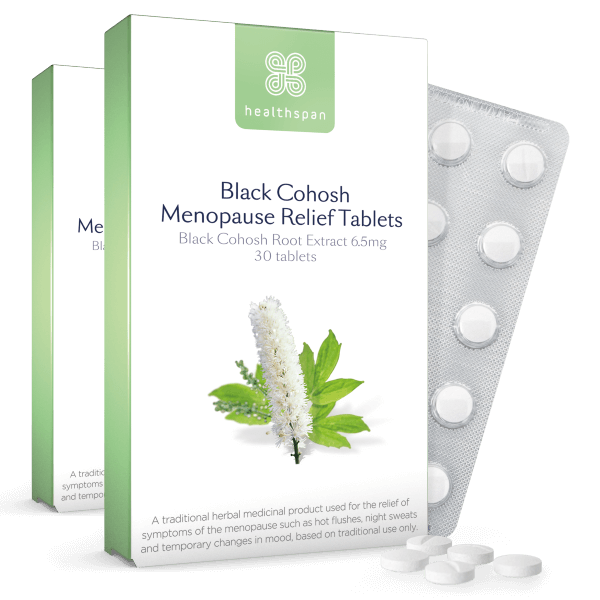As women approach menopause, the ovaries reduce production of the female sex hormones oestrogen and progesterone. A key symptom which frequently accompanies these changes is hot flushes.
Hot flushes may occur during the day or at night, resulting in facial burning and tingling, and sweats that drench the body.
Since this can interrupt sleep, hot flushes can be the cause of considerable discomfort and inconvenience. This lack of sleep can exacerbate other symptoms also experienced during menopause, such as tiredness, irritability, headaches and mood swings.
Medically the answer is the prescription of HRT to help address the balance of hormones, but many women would rather use a natural alternative. A number of factors can be considered to support hormonal health, including the quality of the diet, key nutrients and specific herbs: in particular, black cohosh.
What is black cohosh?
Black cohosh is a tall perennial herb, originally found in the north eastern United States. It is the root of this herb that is used, first applied for medicinal purposes by Native American Indians, and later becoming a popular treatment for women's health issues in Europe, particularly Germany, in the mid-1950s.
A number of clinical research studies have been conducted to investigate how black cohosh works at a cellular level. Scientists have found that this herb acts as a 'selective oestrogen receptor modulator' (SERM). This is different to usual phytoestrogens (e.g. red clover), which are plant based substances with actions similar to oestrogen. Black cohosh does not have general oestrogen-like actions, but its SERM properties stimulate oestrogen receptors in some parts of the body, and not others, therefore working only where needed. In certain areas of the body, black cohosh might increase the effects of oestrogen, while in other parts it might decrease oestrogenic affects.
This is particularly beneficial during menopause, when it can block stimulation of oestrogen in the womb and breasts, thus helping to prevent tumour growth. Black cohosh does however increase oestrogen in certain necessary places, including the bones, where it can help to protect against oesteoporosis, and the vagina, assisting in the reduction of vaginal dryness.
It is these same SERM properties of black cohosh that make it beneficial for hot flushes. To understand its role in reducing the uncomfortable symptoms of tingling, flushing and heavy sweats, let us first consider in more detail what is happening when a hot flush is experienced.
Oestrogen levels and black cohosh
Experts believe that when oestrogen falls, the hypothalamus (the section of the brain responsible for producing some hormones) is adversely affected. One role of the hypothalamus is to regulate body temperature, so the decrease in oestrogen causes the brain to detect too much body heat. It is thought that as a natural reaction to this the brain releases hormones to help lower temperature, leading to an increase in heart rate and a dilation of blood vessels in order to allow more blood to flow through the vessels in an effort to reduce body warmth.
The increased blood flow also causes the body to sweat: another natural response to reduce heat. This sequence of events is thought to be behind the burning, intense warmth and sweaty feeling experienced during a hot flush. The SERM properties of black cohosh offset the decline of oestrogen in the hypothalamus, providing plant compounds that selectively bind to brain cells, and so counteract the declining oestrogen levels, thus preventing the cascade of events that lead to hot flushes.
Treatment, intake and effects
Clinical trials with black cohosh have been encouraging yet not fully consistent, demonstrating that for some women black cohosh may be sufficient on its own, while for others dietary intake and nutritional supplements may also need to be taken into consideration. It might also be beneficial to bear in mind that stimulants found in coffee, tea, chocolate and alcohol can intensify hot flushes. Why some women experience hot flushes and not others may be dictated by genetics and ethnicity, or as one study revealed, women who have naturally lower progesterone levels tend to suffer more severe symptoms. Taking black cohosh and ensuring your diet is as nutrient-rich as possible may provide sought-after relief to hot flushes.
Reported adverse symptoms including gastrointestinal upsets, rashes and headaches are mild and reversible. Single cases of liver damage have been reported, but these have no clear association with taking black cohosh.
Please note that before taking herbal supplements it is important to speak with your doctor to ensure that they are suitable for your requirements, especially if you are taking any medication.
For more advice and information about the menopause, select Menopause from the Your health menu above.

Black Cohosh Menopause Relief
Traditional Herbal Medicine (THR) for menopause symptoms
- Traditionally used to help relieve menopause symptoms such as hot flushes, night sweats and mood swings
- Registered Traditional Herbal Medicine, regulated by the MHRA







